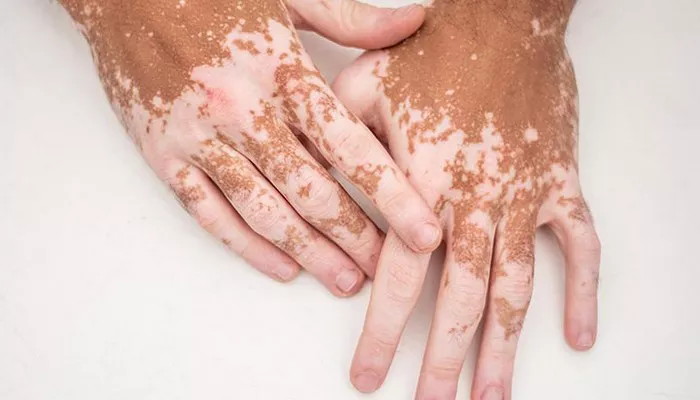Vitiligo is a chronic skin condition characterized by the progressive loss of skin pigmentation, resulting in white patches that contrast with the surrounding skin. This article will delve into the details of vitiligo, including its symptoms, how it differs from similar conditions, the importance of professional diagnosis, and the emotional and practical aspects of managing the condition.
SEE ALSO: Is Vitiligo Contagious?
Explain Vitiligo and its Symptoms
Vitiligo is an autoimmune disorder where the immune system attacks the melanocytes, the cells responsible for producing melanin, the pigment that gives skin its color. As a result, the affected skin loses its color, leading to noticeable white patches.
Primary Symptoms of Vitiligo:
Depigmentation: The main symptom of vitiligo is the appearance of white patches on the skin. These patches occur due to the loss of melanin, which results in areas that are lighter than the surrounding skin. The depigmentation can vary in size and shape and may appear on any part of the body.
White Patches: Vitiligo often starts with small, irregularly shaped white patches. These patches can be anywhere on the body but are commonly found on areas exposed to the sun, such as the face, hands, and arms. As the condition progresses, these patches can spread and merge.
Changes in Hair Color: In addition to skin depigmentation, vitiligo can affect hair color. Hair in the areas where the skin is affected may turn white or gray. This change is due to the loss of melanin in the hair follicles.
Early Stages: In the initial stages of vitiligo, the patches may be small and faint. They often appear on sun-exposed areas and may initially be mistaken for other conditions or simply not noticed until they become more pronounced.
Illustrative images of vitiligo progression can help in understanding the condition better. For instance:
Early Stage: Small, faint patches on the arms or face.
Mid Stage: Larger, more defined patches that may start to merge.
Advanced Stage: Extensive areas of depigmentation, potentially covering large portions of the body.
Distinguish Vitiligo from Similar Conditions
Several skin conditions can cause depigmentation or white patches that may be confused with vitiligo. It’s essential to distinguish vitiligo from these similar conditions to ensure appropriate treatment.
Pityriasis Alba: This condition is characterized by pale patches on the skin, often appearing on the face and trunk. Unlike vitiligo, pityriasis alba patches usually have a scaly texture and may be more common in children. The condition is often linked to dry skin and may resolve with improved skin care.
Tinea Versicolor: Caused by a fungal infection, tinea versicolor results in patches of skin that can be lighter or darker than the surrounding skin. These patches are usually found on the chest, back, and shoulders. Unlike vitiligo, tinea versicolor can be treated with antifungal medications.
Albinism: A rare genetic condition, albinism affects melanin production throughout the body, resulting in very pale skin, hair, and eyes. Unlike vitiligo, which develops over time and may affect only certain areas, albinism is present from birth and affects the entire body.
It is crucial to seek a professional diagnosis from a dermatologist to accurately identify the condition and receive appropriate treatment.
Guidance on Seeking Medical Advice
Early detection and intervention are key to managing vitiligo effectively. Consulting a dermatologist is important for several reasons:
Accurate Diagnosis: A dermatologist can confirm whether the white patches are due to vitiligo or another condition. Accurate diagnosis is crucial for determining the best course of treatment.
Treatment Options: Various treatments are available for managing vitiligo, including topical corticosteroids, phototherapy, and skin grafting. Early consultation allows for timely initiation of treatment, which can help in controlling the spread of the condition and improving the appearance of the skin.
Preventing Progression: Early treatment may help slow or halt the progression of vitiligo, preventing the white patches from spreading further and causing additional cosmetic concerns.
Address Potential Concerns and Anxiety
A diagnosis of vitiligo can be emotionally challenging. The visible nature of the condition may affect self-esteem and lead to anxiety or social concerns. It’s important to address these emotional aspects:
Support Resources: Online communities and support groups can provide valuable emotional support and practical advice for managing vitiligo. Connecting with others who have the condition can offer comfort and insights into coping strategies.
Psychosocial Support: Professional counseling or therapy can help individuals navigate the emotional impact of vitiligo. Addressing any feelings of anxiety or self-consciousness with a mental health professional can be beneficial.
Awareness and Education: Educating oneself and others about vitiligo can help reduce stigma and promote understanding. Awareness can foster a supportive environment and mitigate some of the social challenges associated with the condition.
In conclusion, vitiligo is a complex condition with significant implications for those affected. Understanding its symptoms, distinguishing it from similar conditions, and seeking timely medical advice are crucial steps in managing the condition effectively. Additionally, addressing the emotional and psychosocial aspects of vitiligo is essential for improving quality of life and overall well-being.
Related Topics:



























